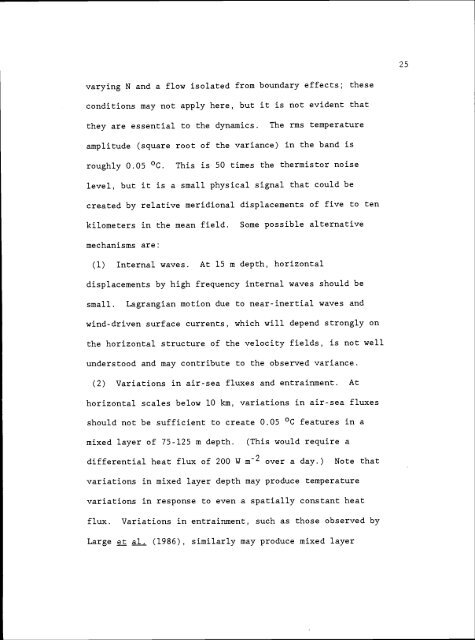Observations and Modelling of Fronts and Frontogenesis
Observations and Modelling of Fronts and Frontogenesis
Observations and Modelling of Fronts and Frontogenesis
Create successful ePaper yourself
Turn your PDF publications into a flip-book with our unique Google optimized e-Paper software.
varying N <strong>and</strong> a flow isolated from boundary effects; these<br />
conditions may not apply here, but it is not evident that<br />
they are essential to the dynamics.<br />
The rins temperature<br />
amplitude (square root <strong>of</strong> the variance) in the b<strong>and</strong> is<br />
roughly 0.05 °C. This is 50 times the thermistor noise<br />
level, but it is a small physical signal that could be<br />
created by relative meridional displacements <strong>of</strong> five to ten<br />
kilometers in the mean field. Some possible alternative<br />
mechanisms are:<br />
(1) Internal waves. At 15 m depth, horizontal<br />
displacements by high frequency internal waves should be<br />
small. Lagrangian motion due to near-inertial waves <strong>and</strong><br />
wind-driven surface currents, which will depend strongly on<br />
the horizontal structure <strong>of</strong> the velocity fields, is not well<br />
understood <strong>and</strong> may contribute to the observed variance.<br />
(2) Variations in air-sea fluxes <strong>and</strong> entrainment. At<br />
horizontal scales below 10 km, variations in air-sea fluxes<br />
should not be sufficient to create 0.05 °C features in a<br />
mixed layer <strong>of</strong> 75-125 m depth. (This would require a<br />
differential heat flux <strong>of</strong> 200 W m2 over a day.) Note that<br />
variations in mixed layer depth may produce temperature<br />
variations in response to even a spatially constant heat<br />
flux. Variations in entrainment, such as those observed by<br />
Large (1986), similarly may produce mixed layer<br />
25















